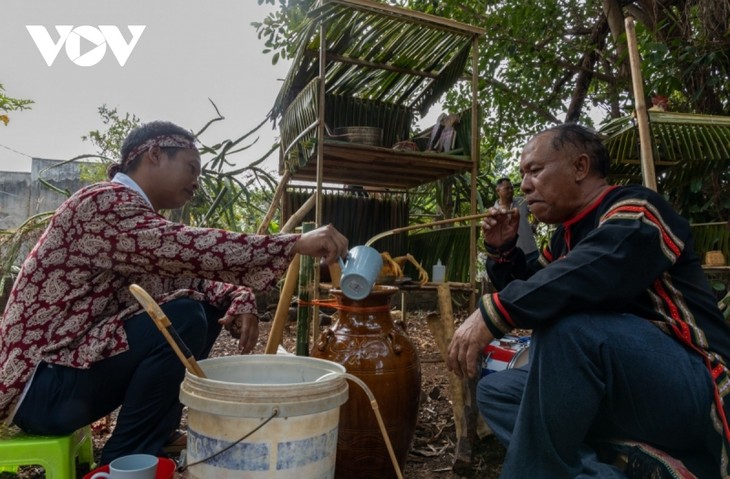(VOVWORLD) - April is the peak of the dry season in the Central Highlands. In this month the Ede people in Bon Ma Thuot city, Dak Lak province, hold a ceremony to pray for rain, favorable weather, bountiful crops, a prosperous life, and happiness.
 The shaman holding a stick in each hand and poking holes in the ground. Ede women follow him, sowing seeds in the holes. (photo: VOV) The shaman holding a stick in each hand and poking holes in the ground. Ede women follow him, sowing seeds in the holes. (photo: VOV) |
In the early morning, many people gather at the Ky hamlet community house to prepare for the rain worship ceremony. Young men arrange a set of gongs while the women prepare the offerings.
Under the tree at the center of the village, the villagers build a two-storey Pưk hut for the rain ritual. The upper storey is dedicated to the god and goddess and the lower storey is the granary, symbolizing sufficiency. At the foot of the hut they address the evil god, who induces birds and beasts to destroy the fields, causing crop failure and poverty. Next to the hut they place an offering of liquor, chicken, and small wooden statues of elephants, tigers, and hedgehogs.
When the gongs are played, the shaman stands in front of the Puk hut and begins the ritual. He prays to the gods of the sky, the earth, and the rain to pour water down on the fields for the plants to grow. Water makes the rice grow well so they will have a bountiful harvest and a full warehouse. They ask the gods to chase away beasts and evil spirits from the village.
Then the shaman uses his feet to draw small squares on the ground representing the fields. He walks from square to square, holding a stick in each hand and poking holes in the ground. Ede women follow him, sowing seeds in the holes.
H’By La Byă of Ky hamlet said: “This is the first time I’ve attended a rain ceremony. I don’t know much about it. I’m proud to attend the ceremony and learn more about the Ede’s customs.”
 After the ceremony all villagers drink and eat together. (photo: VOV) After the ceremony all villagers drink and eat together. (photo: VOV) |
The shaman holds a bowl of liquor and splashes liquor on the rice containers, farm tools, and on the ground to invite the deities to drink. He offers liquor to the gods and goddesses in the hut, as well as the animal traps and scarecrows in the fields. When the ritual ends, everyone cheers to show unity and a determination to begin a new farming season.
65-year-old H'Luch Hdok said: "I’m very moved. It’s important to hold this annual rain ceremony before a new crop. It reminds me of my childhood, when I first attended the ceremony. Now the ritual has been revitalized. I’m very happy to see it again.”
Y Bang Byă, the chief of Ky hamlet, said that in the past the Ede always held the rain ceremony in April, at the peak of the dry season. After burning the field, they waited for the next rain to sow seeds. Since they shifted from growing rice to growing pepper and coffee, they use new production techniques that make them less dependent on the weather, so the rain ceremony has been neglected. But in recent years the State and the culture sector have encouraged the Ede to revitalize their traditional festivals and cultural practices.
Hamlet chief Y Bang Byă said: “Protecting ethnic culture is difficult for the villagers. With financial support from the local administration, we’ve been able to hold the rain ceremony once again to pray for good weather, bountiful crops, and sufficiency for our village and others in the Central Highlands.”
Following the ritual, all the villagers and their guests eat the offerings and dance to the gongs to stir up enthusiasm for a new crop.